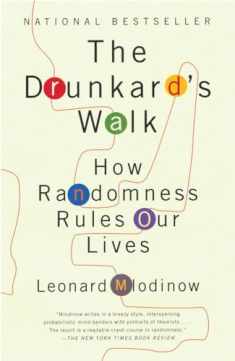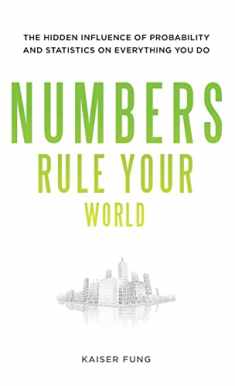
The Signal and the Noise: Why So Many Predictions Fail--but Some Don't
ISBN-13:
9780143125082
ISBN-10:
0143125087
Edition:
Illustrated
Author:
Nate Silver
Publication date:
2015
Publisher:
Penguin Books
Format:
Paperback
576 pages
FREE US shipping
on ALL non-marketplace orders
Marketplace
from $6.50
USD
Marketplace offers
Seller
Condition
Note
Seller
Condition
Used - Very Good
OVER 25 IN STOCK ON 04/23/2024. PAPERBACK. PLEASE NOTE THAT CD-ROM components, access cards/codes, digital license, and other supplemental materials are NOT guaranteed to be included for used items. If their inclusion is essential, please inquire before purchasing to determine whether they are included. Light to moderate wear and creasing to cover/edges/corners. School markings and writing on/inside covers. Minimal markings/highlighting on/inside book, none of which detracts from content. Binding and cover solidly connected.
Seller
Condition
New
Brand New! Not overstocks! Brand New direct from the publisher! Ships in sturdy cardboard packaging.
Book details
ISBN-13:
9780143125082
ISBN-10:
0143125087
Edition:
Illustrated
Author:
Nate Silver
Publication date:
2015
Publisher:
Penguin Books
Format:
Paperback
576 pages
Summary
The Signal and the Noise: Why So Many Predictions Fail--but Some Don't (ISBN-13: 9780143125082 and ISBN-10: 0143125087), written by authors
Nate Silver, was published by Penguin Books in 2015.
With an overall rating of 4.5 stars, it's a notable title among other
Planning & Forecasting
(Management & Leadership, Business, Encyclopedias & Subject Guides, Sports, Social Sciences, Specific Topics, Politics & Government) books. You can easily purchase or rent The Signal and the Noise: Why So Many Predictions Fail--but Some Don't (Paperback, Used) from BooksRun,
along with many other new and used
Planning & Forecasting
books
and textbooks.
And, if you're looking to sell your copy, our current buyback offer is $0.31.
Description
"One of the more momentous books of the decade."—The New York Times Book Review
Nate Silver built an innovative system for predicting baseball performance, predicted the 2008 election within a hair’s breadth, and became a national sensation as a blogger—all by the time he was thirty. He solidified his standing as the nation's foremost political forecaster with his near perfect prediction of the 2012 election. Silver is the founder and editor in chief of the website FiveThirtyEight.
Drawing on his own groundbreaking work, Silver examines the world of prediction, investigating how we can distinguish a true signal from a universe of noisy data. Most predictions fail, often at great cost to society, because most of us have a poor understanding of probability and uncertainty. Both experts and laypeople mistake more confident predictions for more accurate ones. But overconfidence is often the reason for failure. If our appreciation of uncertainty improves, our predictions can get better too. This is the “prediction paradox”: The more humility we have about our ability to make predictions, the more successful we can be in planning for the future.
In keeping with his own aim to seek truth from data, Silver visits the most successful forecasters in a range of areas, from hurricanes to baseball to global pandemics, from the poker table to the stock market, from Capitol Hill to the NBA. He explains and evaluates how these forecasters think and what bonds they share. What lies behind their success? Are they good—or just lucky? What patterns have they unraveled? And are their forecasts really right? He explores unanticipated commonalities and exposes unexpected juxtapositions. And sometimes, it is not so much how good a prediction is in an absolute sense that matters but how good it is relative to the competition. In other cases, prediction is still a very rudimentary—and dangerous—science.
Silver observes that the most accurate forecasters tend to have a superior command of probability, and they tend to be both humble and hardworking. They distinguish the predictable from the unpredictable, and they notice a thousand little details that lead them closer to the truth. Because of their appreciation of probability, they can distinguish the signal from the noise.
With everything from the health of the global economy to our ability to fight terrorism dependent on the quality of our predictions, Nate Silver’s insights are an essential read.
Nate Silver built an innovative system for predicting baseball performance, predicted the 2008 election within a hair’s breadth, and became a national sensation as a blogger—all by the time he was thirty. He solidified his standing as the nation's foremost political forecaster with his near perfect prediction of the 2012 election. Silver is the founder and editor in chief of the website FiveThirtyEight.
Drawing on his own groundbreaking work, Silver examines the world of prediction, investigating how we can distinguish a true signal from a universe of noisy data. Most predictions fail, often at great cost to society, because most of us have a poor understanding of probability and uncertainty. Both experts and laypeople mistake more confident predictions for more accurate ones. But overconfidence is often the reason for failure. If our appreciation of uncertainty improves, our predictions can get better too. This is the “prediction paradox”: The more humility we have about our ability to make predictions, the more successful we can be in planning for the future.
In keeping with his own aim to seek truth from data, Silver visits the most successful forecasters in a range of areas, from hurricanes to baseball to global pandemics, from the poker table to the stock market, from Capitol Hill to the NBA. He explains and evaluates how these forecasters think and what bonds they share. What lies behind their success? Are they good—or just lucky? What patterns have they unraveled? And are their forecasts really right? He explores unanticipated commonalities and exposes unexpected juxtapositions. And sometimes, it is not so much how good a prediction is in an absolute sense that matters but how good it is relative to the competition. In other cases, prediction is still a very rudimentary—and dangerous—science.
Silver observes that the most accurate forecasters tend to have a superior command of probability, and they tend to be both humble and hardworking. They distinguish the predictable from the unpredictable, and they notice a thousand little details that lead them closer to the truth. Because of their appreciation of probability, they can distinguish the signal from the noise.
With everything from the health of the global economy to our ability to fight terrorism dependent on the quality of our predictions, Nate Silver’s insights are an essential read.


We would LOVE it if you could help us and other readers by reviewing the book
Book review

Congratulations! We have received your book review.
{user}
{createdAt}
by {truncated_author}




